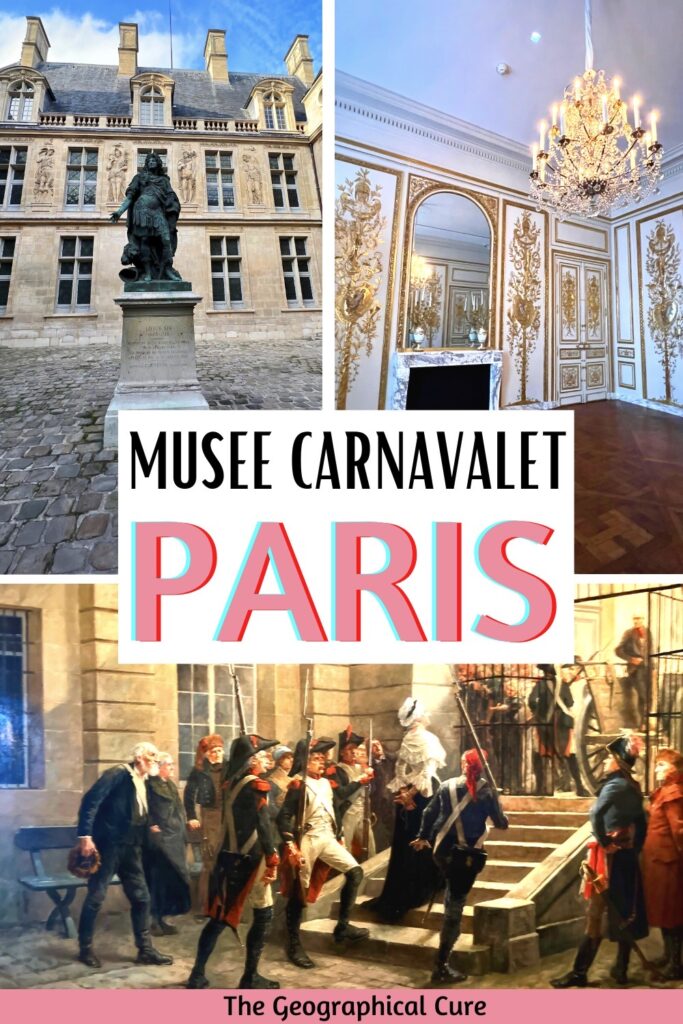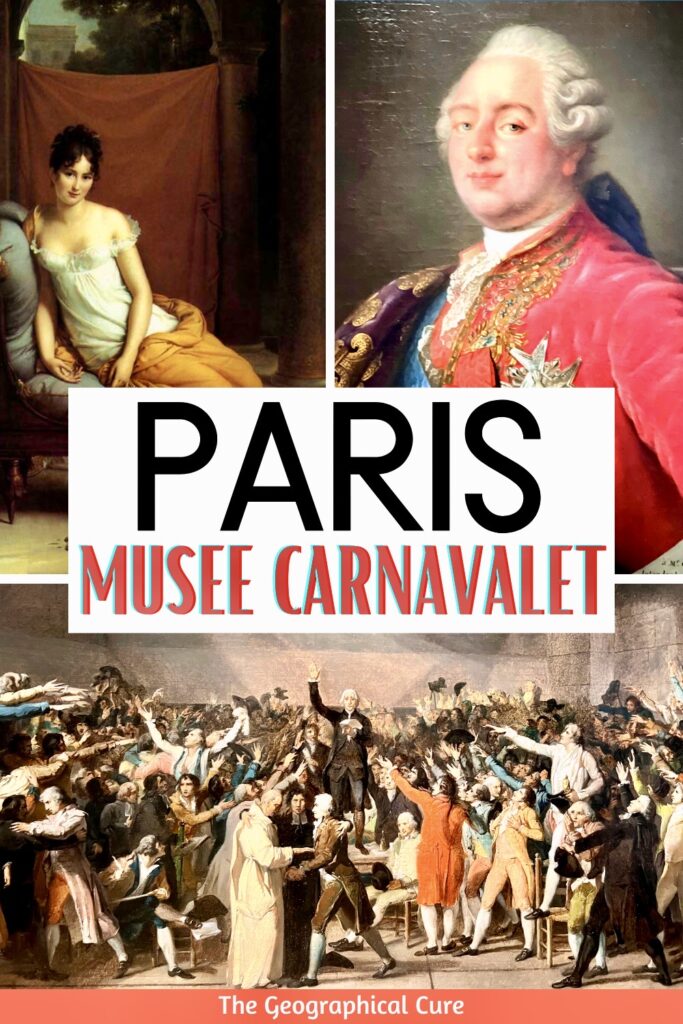The Musée Carnavalet is the most Parisian of all Paris museums. Housed in two adjacent hôtels particuliers in the heart of the Marais, it’s the oldest museum in Paris.
In this guide to the Musée Carnavalet, you’ll discover everything to see inside this compelling Paris history museum.
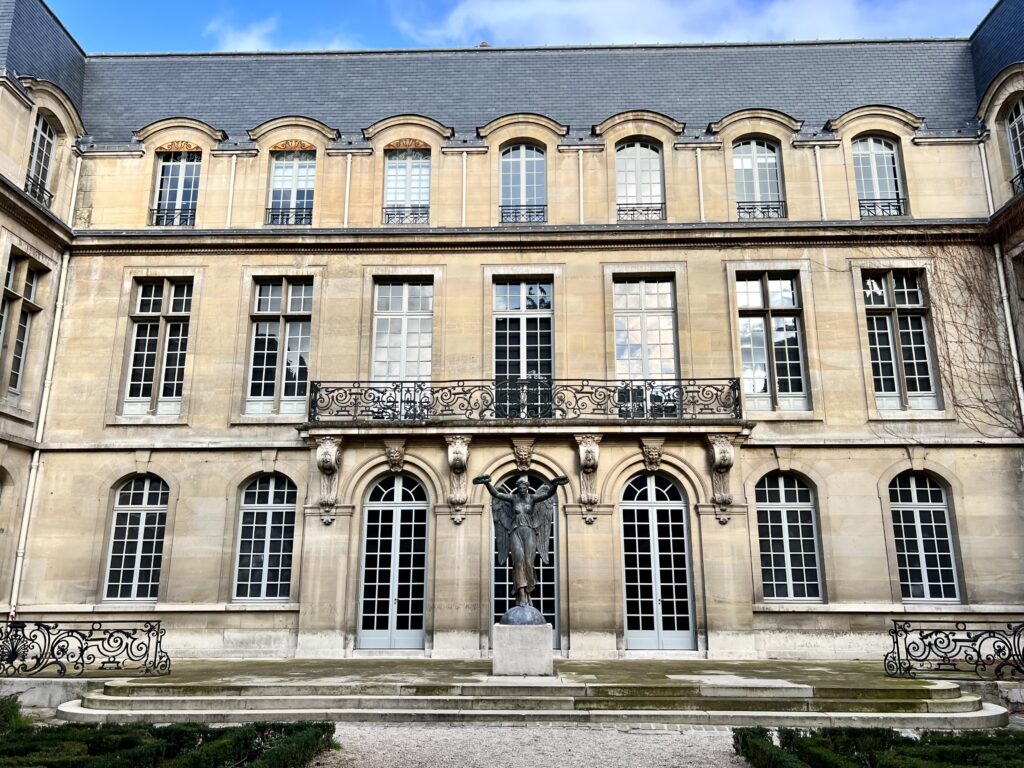
The Carnavalet documents the history of Paris in chronological order from its prehistoric origins to the present day. Throughout the 85 exhibition rooms, you’ll discover a feast of art and history.
The hodgepodge collection showcases everyday objects, models, historical curiosities, decorative art, and fine art.
Indeed, whole buildings, storefronts, glamorous period rooms, and art collections are on view, so it’s like a warehouse of small museums, with no end of surprises.
History And Overview Of The Musee Carnavalet
The Musee Carnavalet was the brain child of Baron Haussmann, the man who transformed the cityscape of Paris with grand boulevards. In 1866, he asked the city to acquire the Hotel Carnavalet to store the interiors of buildings he had razed and create a history museum.
Built between 1548-60, Renaissance architect Mansard reworked the facade and wings. In 1880, the museum opened to the public. Over 150 years, the museum’s collection has been continually enriched.
Beginning in 2016, the museum underwent a massive $65 million renovation. It was completed with the help of François Châtillon, chief architect for France’s historical monuments.
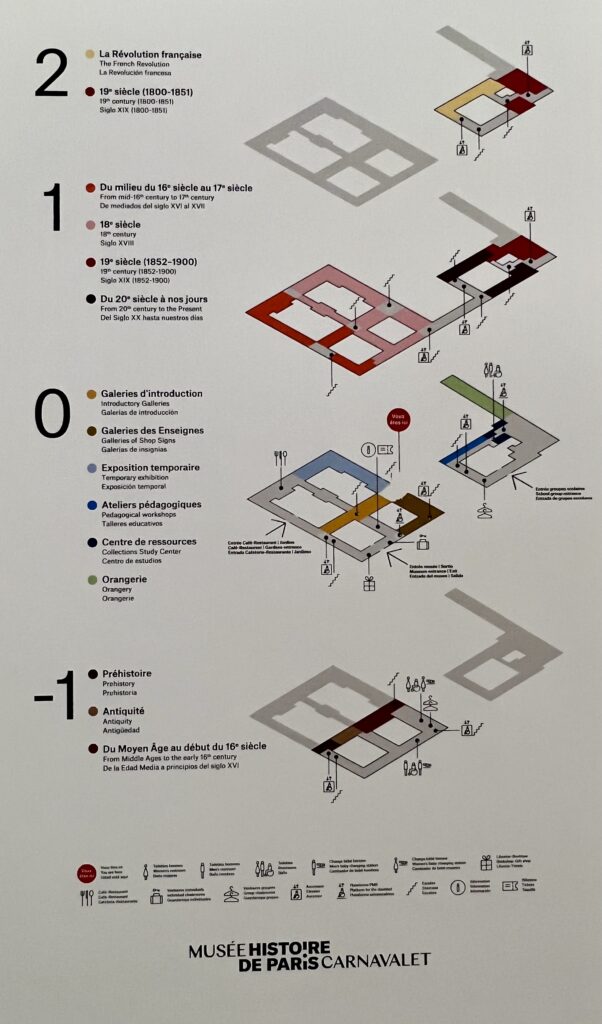
The redesign created a new chronological route and added much more display space. 60% of the items now on display were previously in storage.
Two new spaces introduce the city of Paris and outline the origins of the museum. New digital displays add a touch of modernity. Thankfully, museum labels are now in English as well as French.
Guide To The Musee Carnavalet: What To See
Here are some of the must see highlights of the Musee Carnavalet, presented roughly in the order you’ll encounter them following the museum path.
Unless you’re a stickler for chronology, you might want to begin with the French Revolution exhibits on the top floor. There’s just so much to see at the Carnavalet and you’ll want to save ample time for that impressive collection.
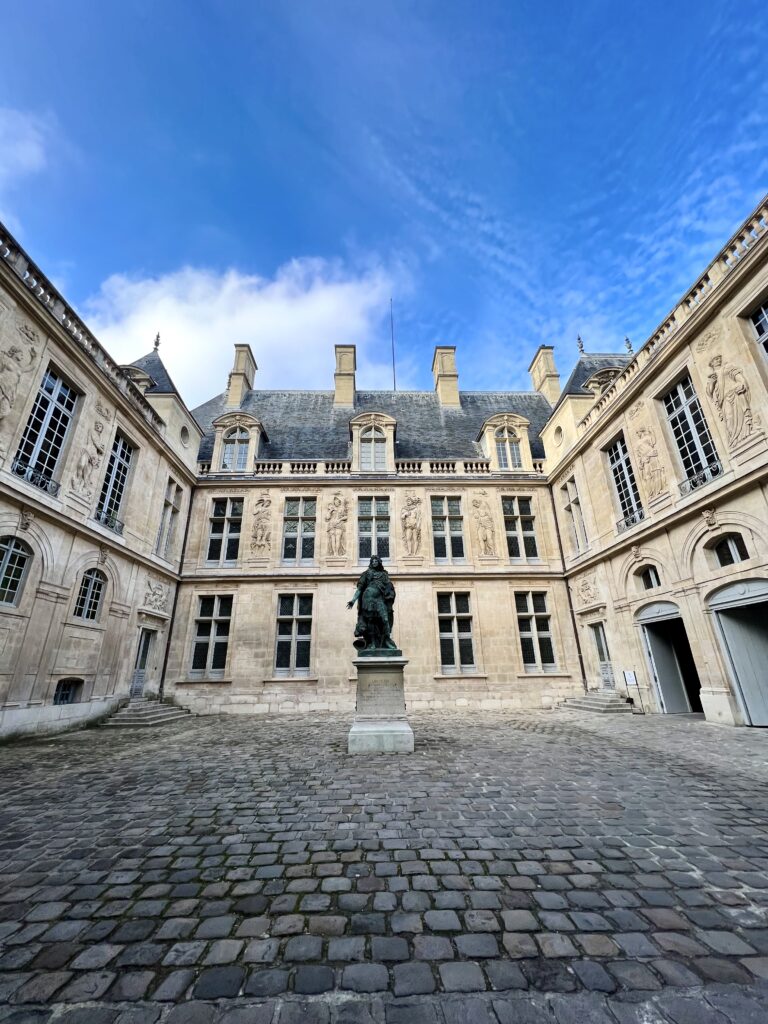
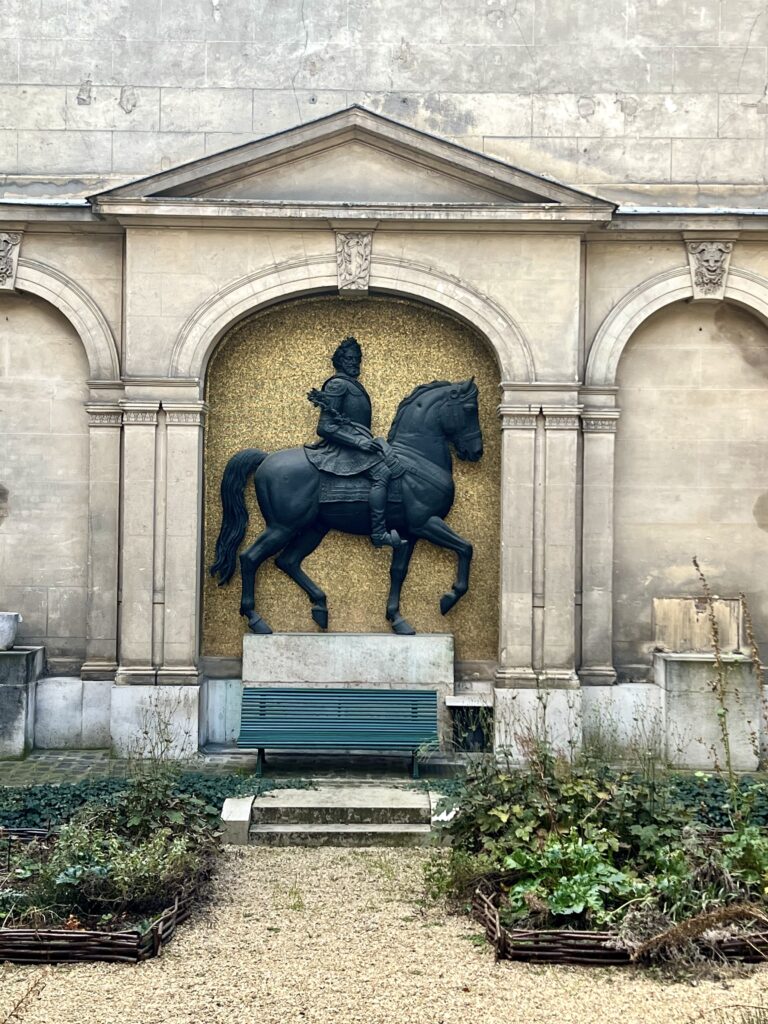
1. Courtyards
The Renaissance courtyards of the museum are simply stunning. You’ll be wrapped in evidence of the ancien regime.
The once sooty limestone buildings have been returned to their original honey color. Bas reliefs and sculptures by Jean Goujon adorn the facade.
In the central courtyard is a rare surviving pre-revolutionary bronze sculpture of Louis XIV, the Sun King. In the courtyard of Victory, installed in 1950, is a dramatic statue of Victory holding out her laurels.
2. Hall of Signs
The first room you’ll enter is filled with signs evoking a Paris street, which date from the 17th to the early 20th centuries.
In the past, when literacy rates in Paris were lower, businesses created signs with images advertising the nature of their shops.
Among the highlights is a freaked-out-looking black cat on a crescent moon from the famous 19th century Chat Noir cabaret.
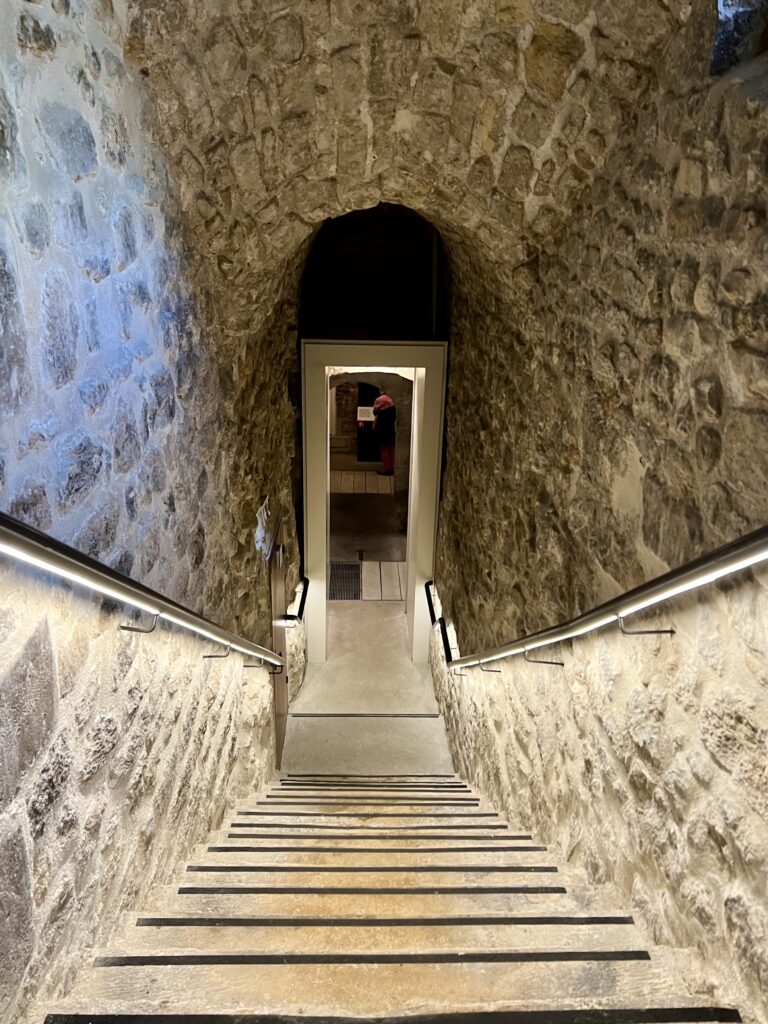
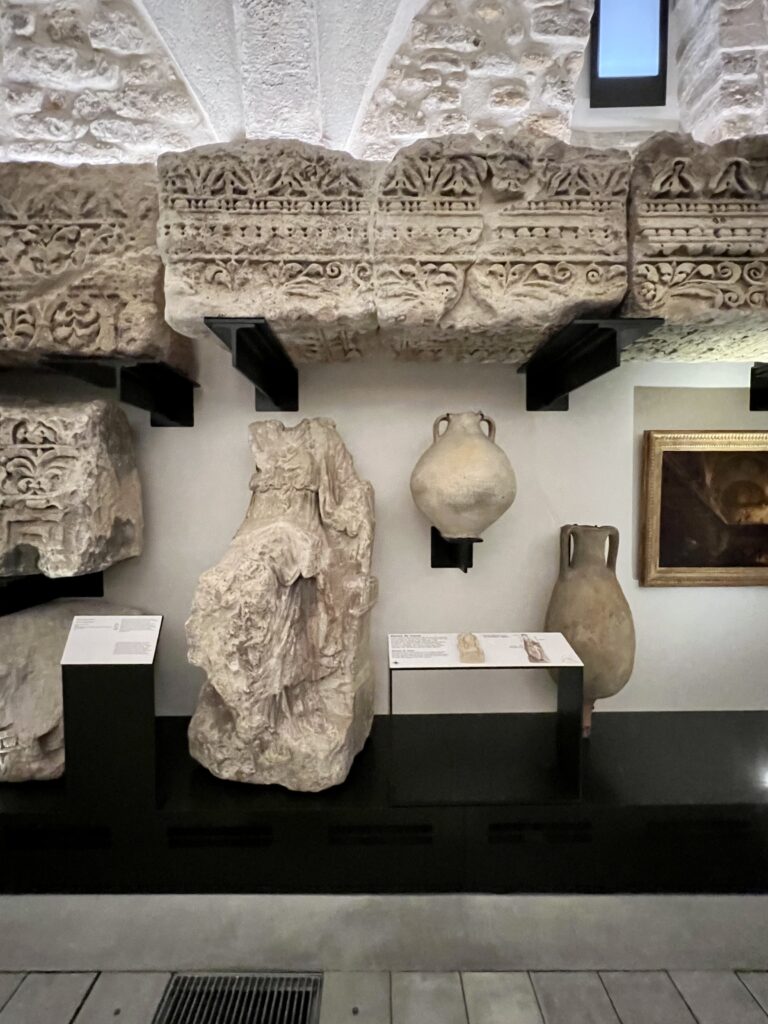
3. Prehistory
The lowest floor is a newly-opened vaulted space featuring exhibits from Paris’ prehistory, antiquity, and the Middle Ages. A Neolithic oak wood canoe takes pride of place.
In 52 B.C., Paris was the Roman city of Lutetia. There was once a public forum, baths, and an amphitheater. In the museum, you’ll find many 1st century Roman stone statues and sarcophagi found while building the Hotel Dieu in 1867.
In the medieval section, you can see a model of the Ile de la Cite in 1520, which was made by a monk around 1900. There is a gargoyle from Notre Dame, everyday objects, tombstones, and funeral steles.
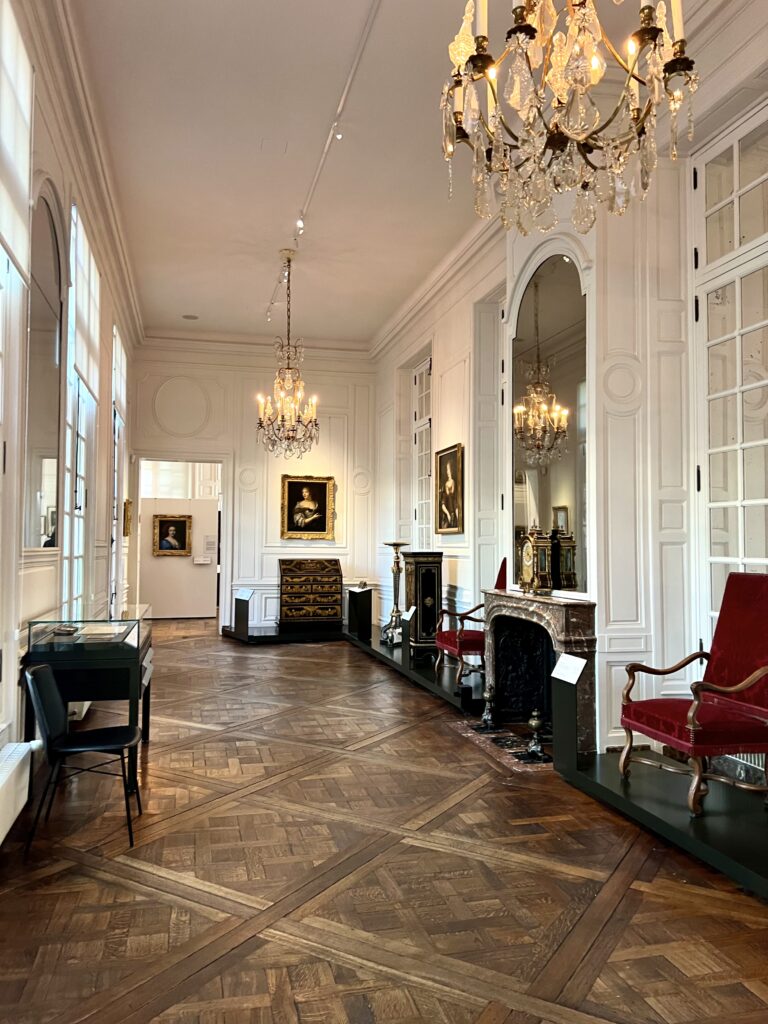
4. Madame de Sévigné Room
The first floor of the Carnavalet contains some 20 period rooms, showing how aristocratic Parisians once lived. The first set are the apartments of Madame de Sévigné.
One of Paris’ most famous and colorful citizens, the madame once lived in the Hotel Carnavalet.
She was a gifted chronicler and a key figure of the intellectual and social life in the 17th century. Her letters provide insight into French politics and history.
In three rooms, visitors will discover a portrait of the famous letter writer, a rare letter to her daughter, and the lacquered writing desk she used to pen her letters.
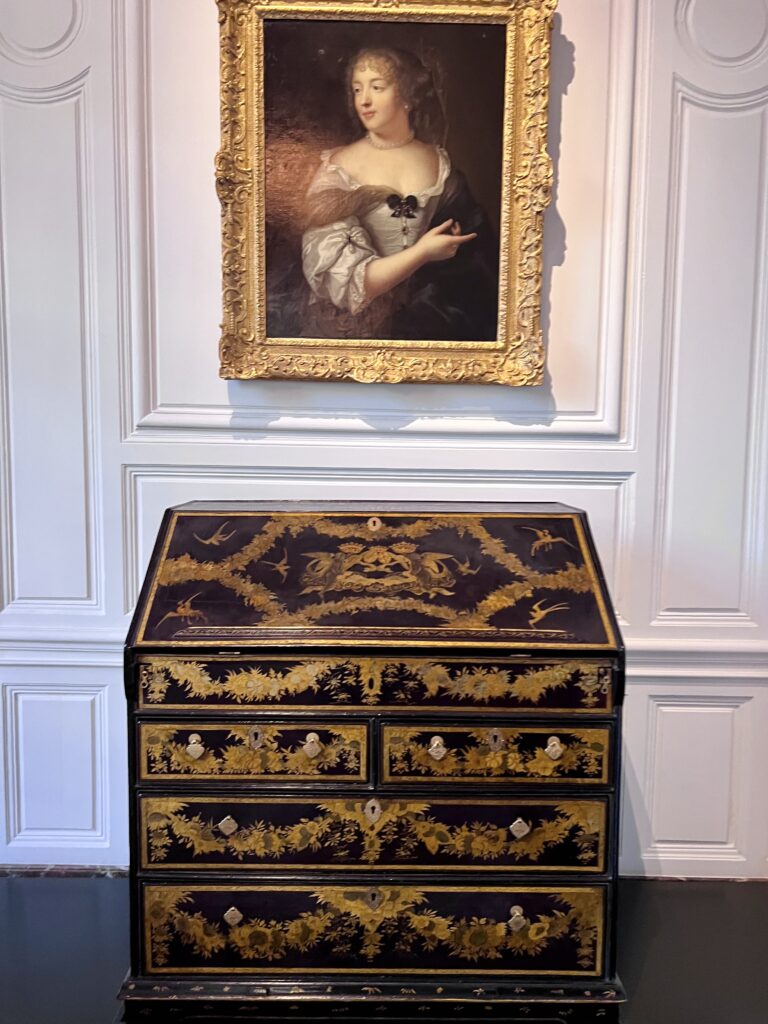
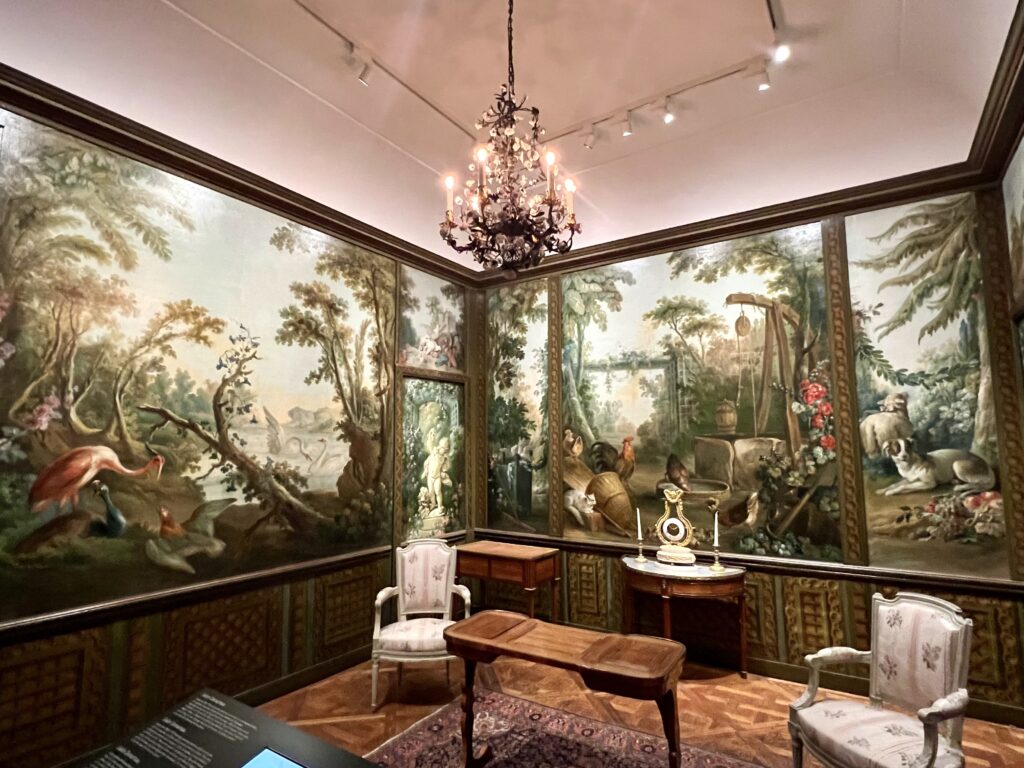
5. Demarteau Salon
The Demarteau Salon is a beautiful space. You can only peak inside; you can’t enter it for closer inspection.
The salon was formerly in the mansion of Gilles Demarteau on the Ile de la Cite. The panels were completed between 1765 and 1770.
The frescos were painted by the greatest artists of the time — Fragonard, Boucher, and Huet. They depict an idyllic countryside with lush vegetation and domestic animals.
The furniture is from the same period.
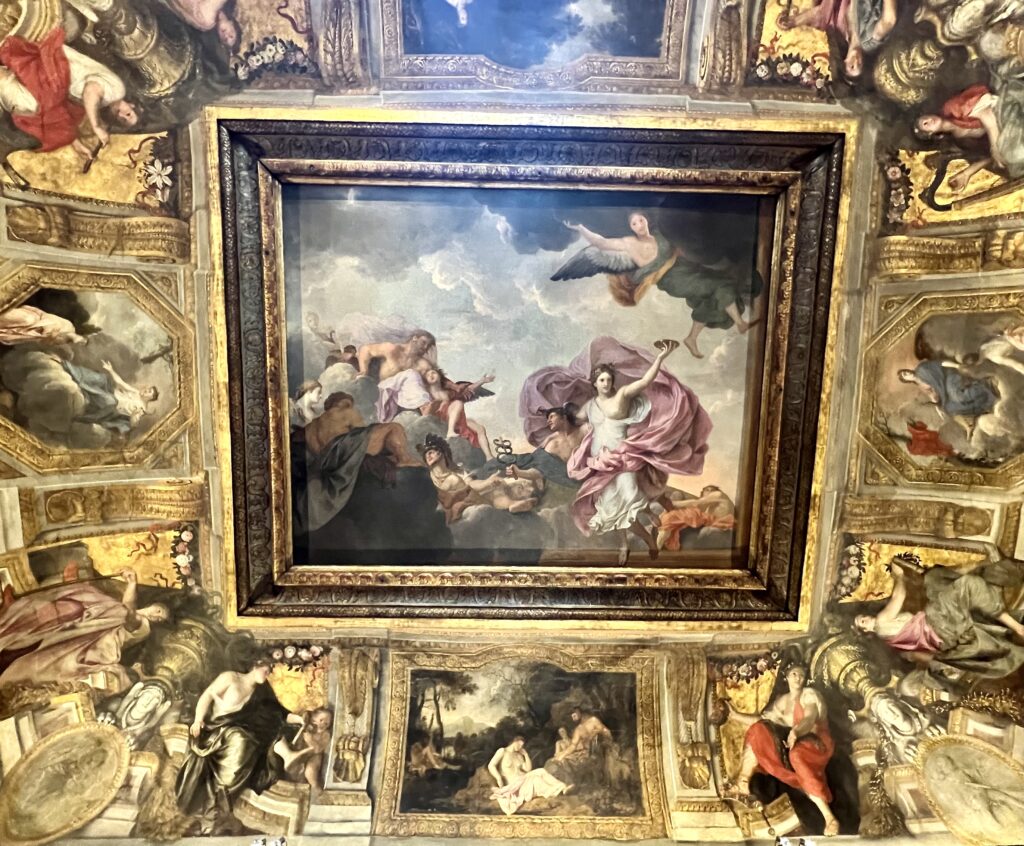
6. Le Brun Ceiling from the Hôtel de la Rivière
This is one of the most beautiful Parisian interiors from the 17th century.
In 1652, Charles Le Brun was entrusted with decorating the mansion belonging to Louis Barbier on what is now 14 Place des Vosges. Le Brun was the first court painter for King Louis XIV and remained so for 30 years.
In the fresco, Mercury presents Psyche to her husband Cupid. They are about to drink some ambrosia, the nectar of the gods.
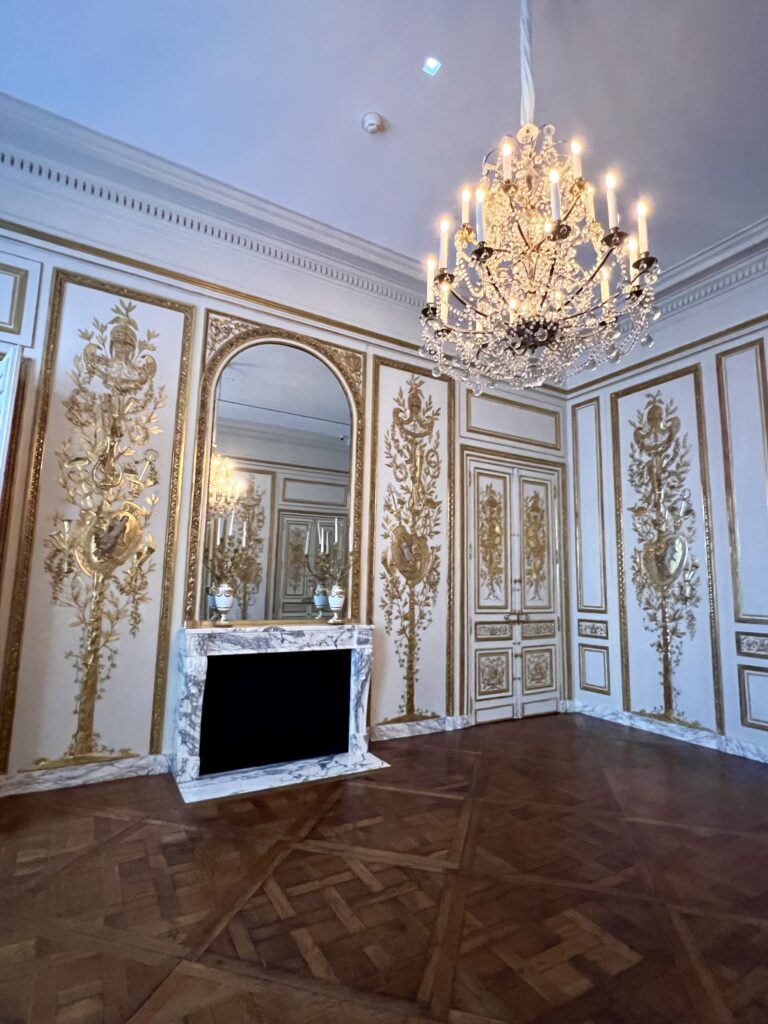
7. Guest Salon of the Hotel d’Uzes
Perhaps the most luxe period room comes from the Hotel d’Uzes.
The hotel got the Haussmann axe in 1969. It was lavishly decorated and renovated by the young architect Claude-Nicolas Ledoux, but the guest salon was salvaged.
It’s a beautiful Rococo space punctuated by mirrors, double doors, and large panels.
The restored gilt panels are carved with coasts of arms hung on laurels. The doors feature allegories of the four corners of the world.
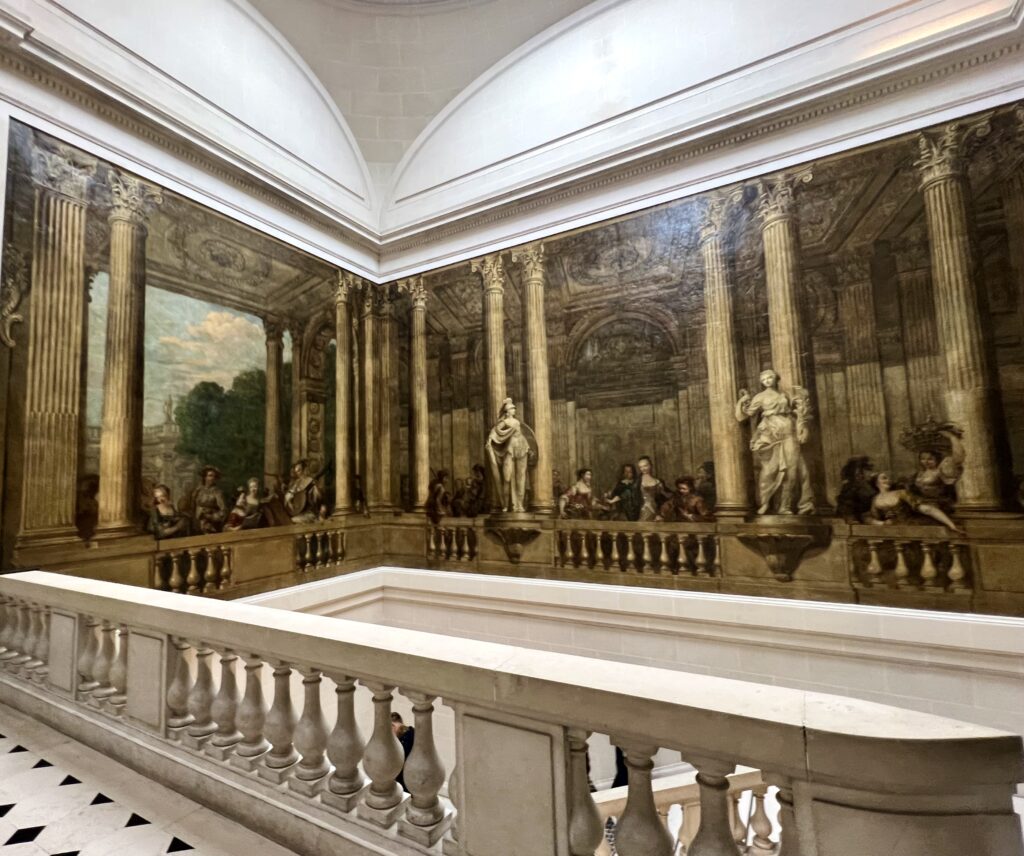
8. Escalier de Luynes
The period rooms all lead to the breathing Luynes staircase, which came from the 17th century Hotel de Luynes on Rue Saint Dominique
The escalier is decorated with a massive 18th century trompe l’oeil fresco by Paolo Antonio Brunetti. It represents the themes of music and love.
Set in a majestic colonnaded decor, statues in various poses seem to watch visitors climbing up and down the stairs.
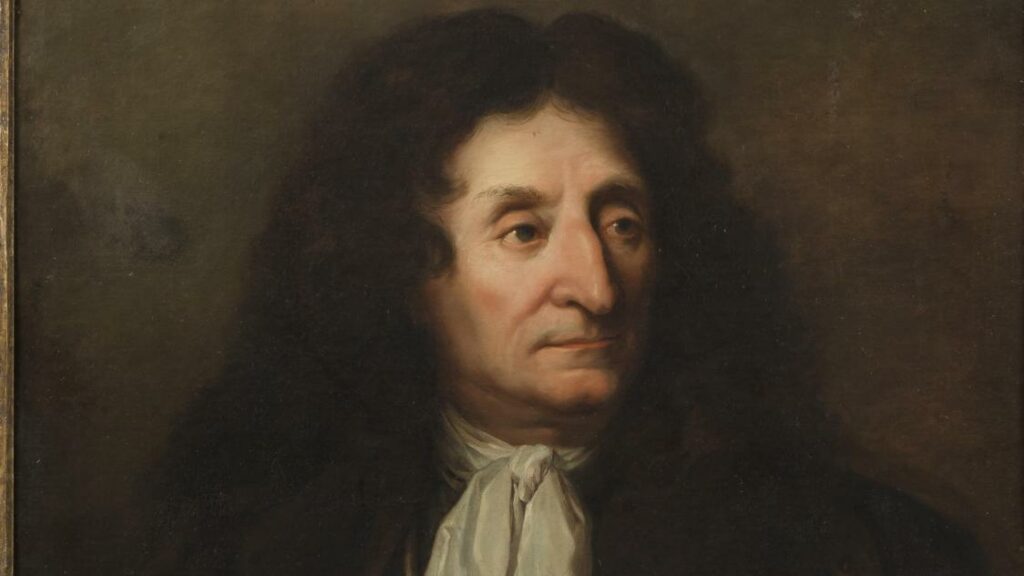
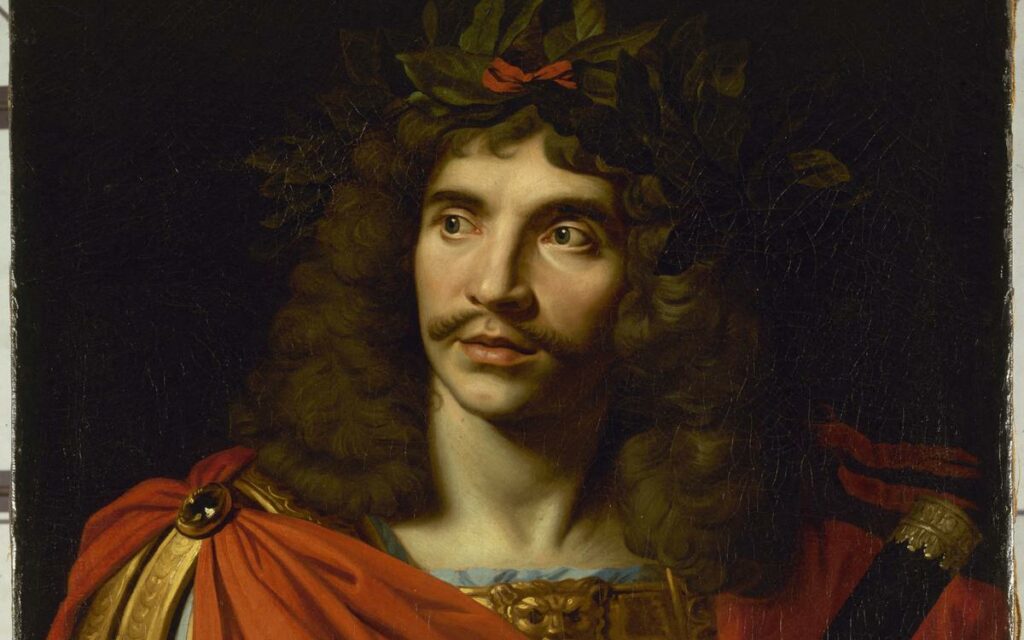
9. Enlightenment Figures
The last part of the pathway on the first floor focuses on the intellectual figures of the Enlightenment era.
On opposite sides of the Luynes landing, the encyclopedists Diderot and Jean Le Rond d’Alembert face the philosophers Voltaire and Jean-Jacques Rousseau.
10. French Revolution Exhibits
Head up a stairway to the second floor (third floor to Americans) to see the Carnavalet’s most important collection — the world’s largest cache of art and historic objects about the French Revolution.
No period of history is as charged with the full range of human emotions as the French Revolution. It was a period of murder, bloodshed, martyrdom, and rousing speeches.
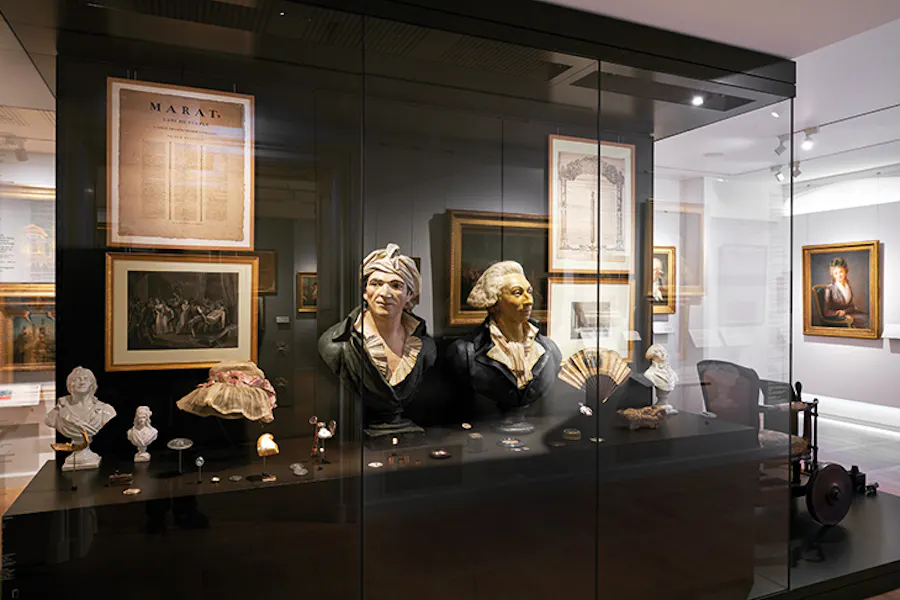
Jacobins like Robespierre, Desmoulins, and Danton wanted to utterly eradicate the crown. They succeeded, but the glorious French Revolution transmogrified into a dark and bloody reign of terror.
In 1792, revolutionary forces captured and arrested King Louis XVI and Queen Marie Antoinette as they attempted to flee the country.
Monarchy was abolished. The king and queen were charged with treason and thrown into the Conciergerie before being executed.
The pathway starts with the painting of the Declaration of the Rights of Man and of the Citizen, which was given to the museum by Georges Clemenceau.
The declaration made freedom the law of the land and stated that the French people (not the monarchy) were the ultimate authority.
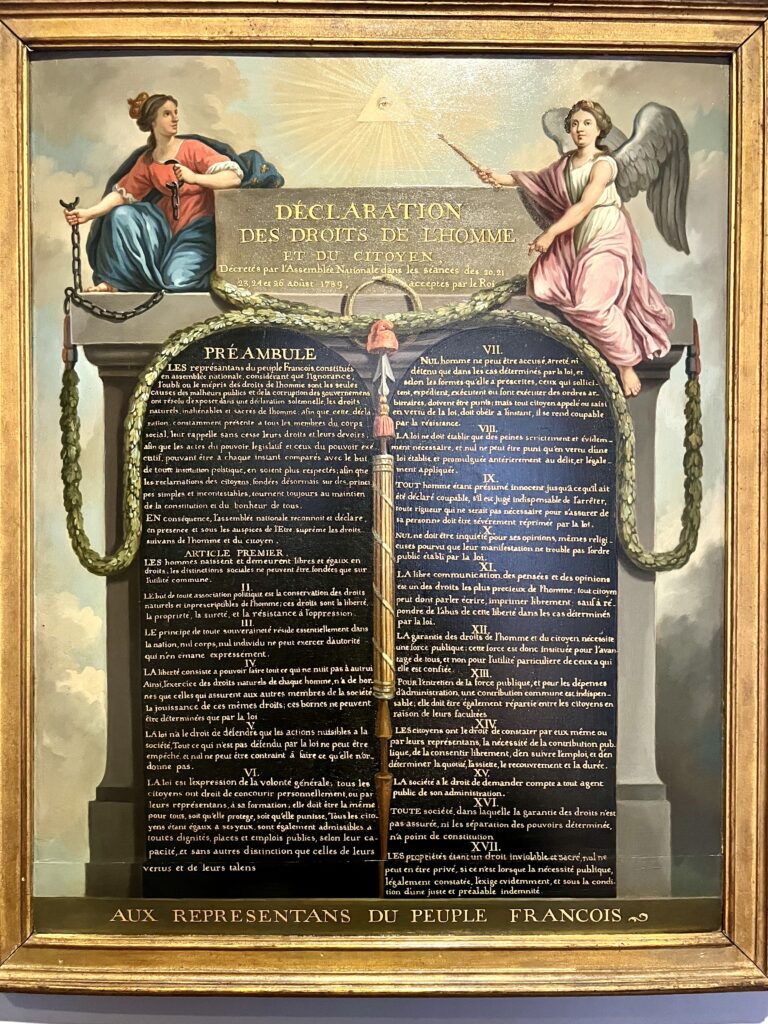
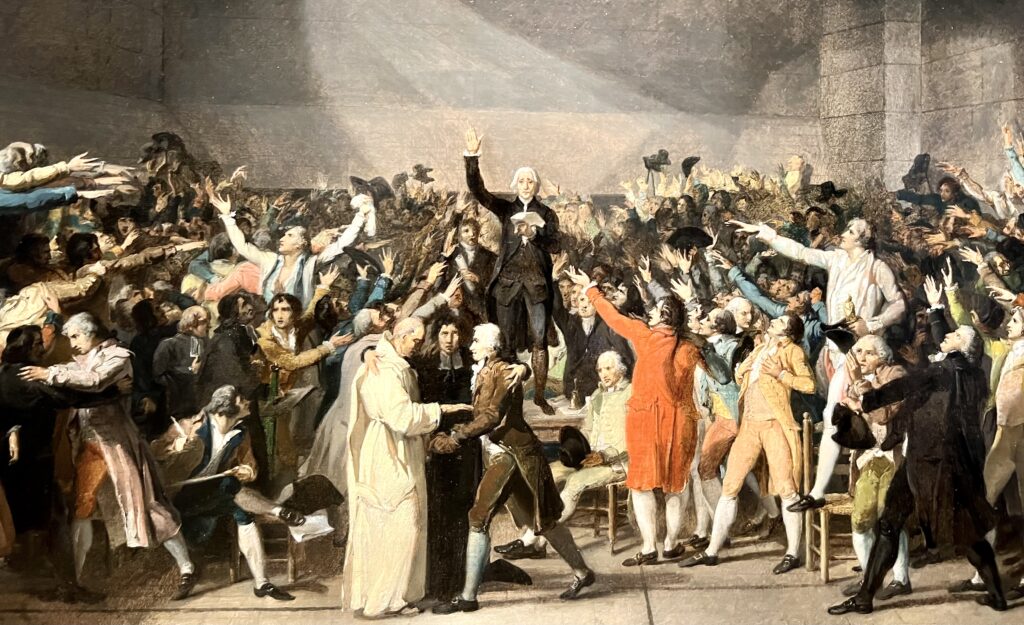
You’ll also see a depiction of the Tennis Court Oath, which was a commitment to a national constitution and representative government, taken by delegates at the Estates-General at Versailles. It’s one of the most iconic scenes of the French Revolution.
Next comes the storming of the Bastille, an event where revolutionaries seized control and demolished the monarchy’s medieval prison.
There are numerous exhibits on the fall, imprisonment, and execution of the Louis XVI and his wife Marie Antoinette — paintings, Marie Antoinette’s slipper, a model of the guillotine, and relics of the royal family.
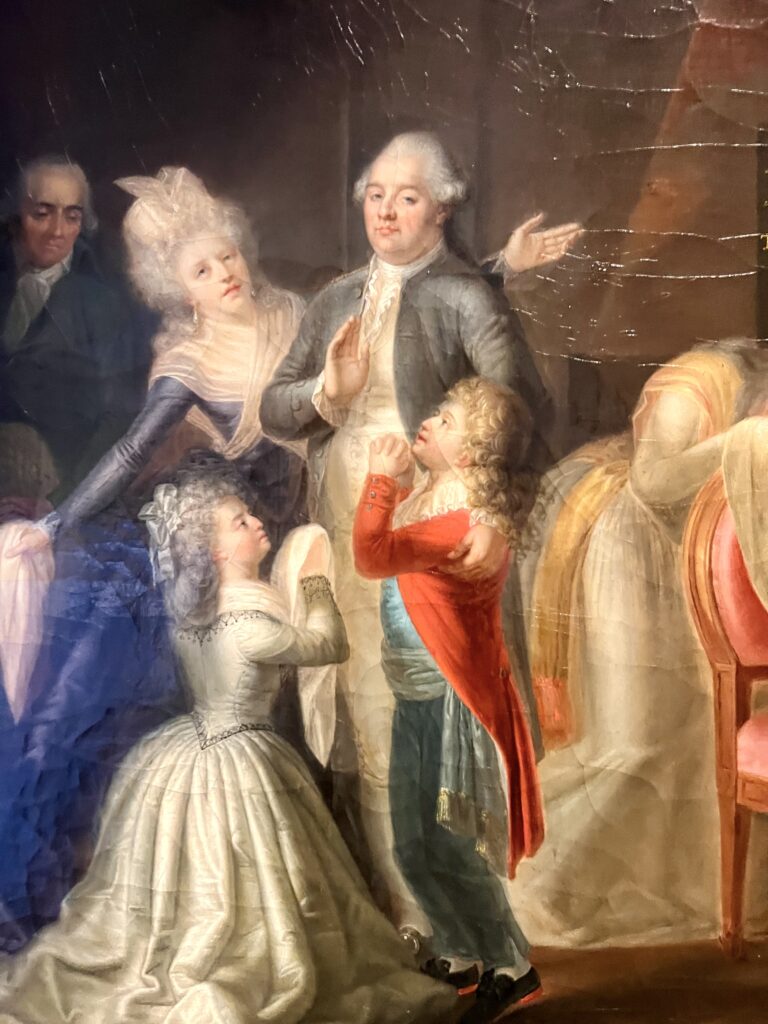
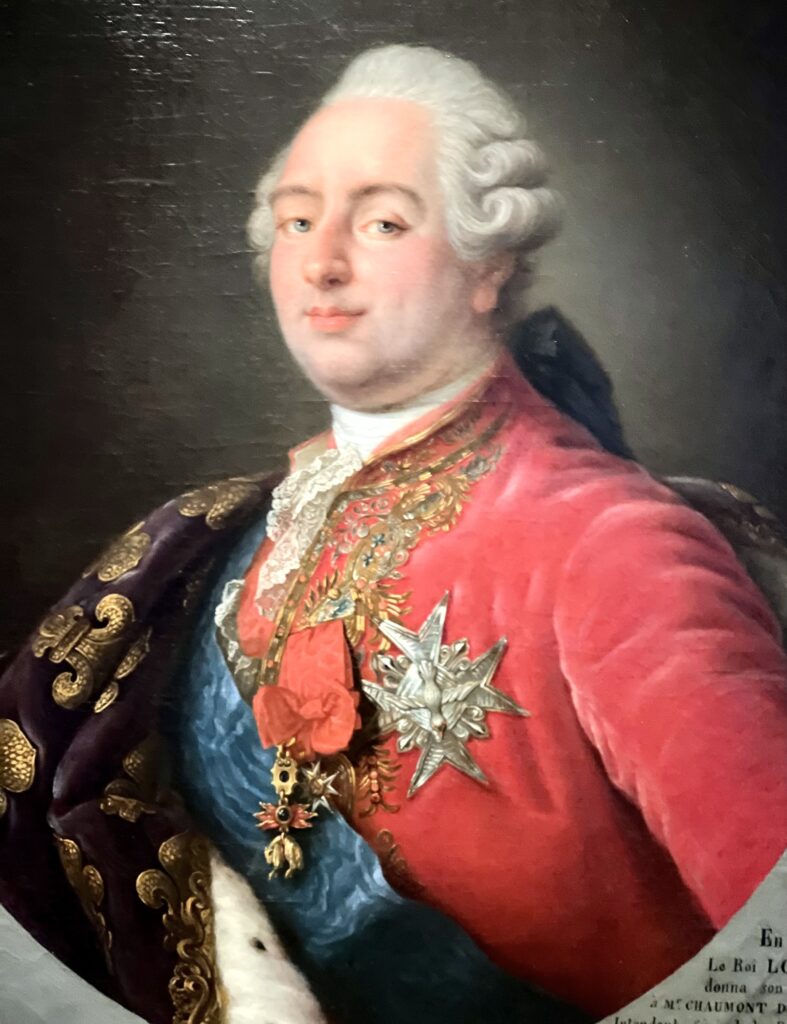
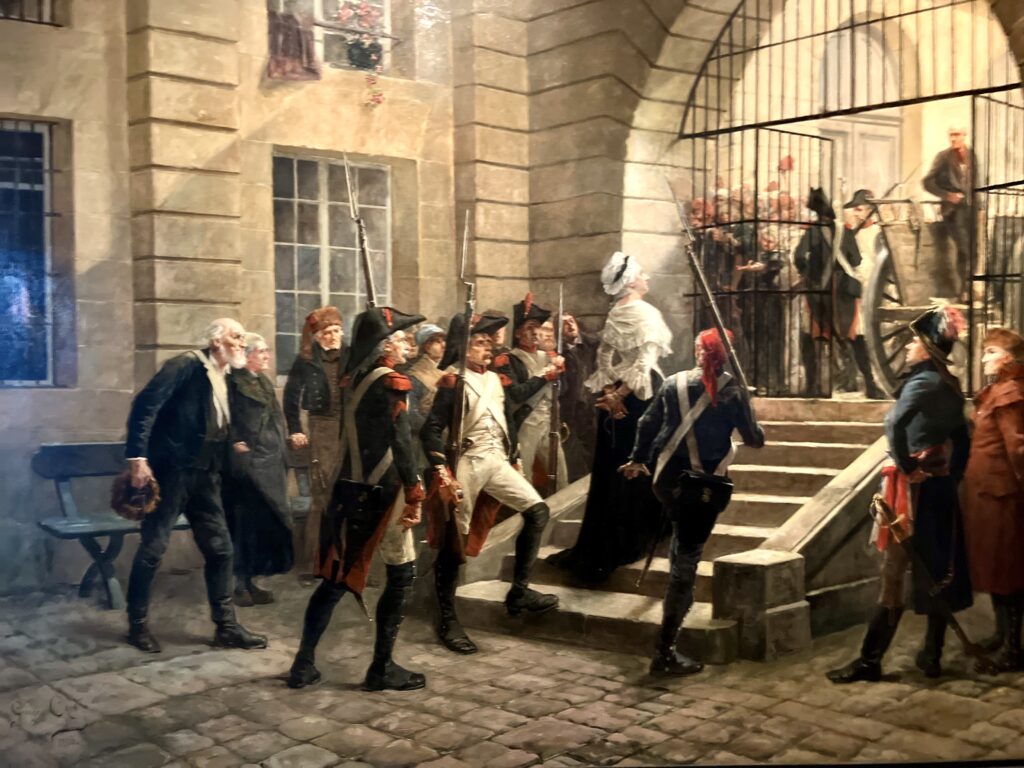
You’ll see several portraits of Marie Antoinette. She was the focus of the citizen’s disgust for her flagrant extravagance and “Let the eat cake!” comment (never happened).
You’ll also find a room (one of my favorites) dedicated to the stars and key players of the revolution, to put faces to names. There are portraits of the famous French revolutionary leaders Camille Desmoulins, Danton, Marat, and Robespierre.
Danton looks like the powerful orator he was with a massive head over a muscular neck, broad brow, and square jaw.
A display case contains a bust of Marat, Charlotte Corday’s bonnet, and the door handles from Marat’s bathroom.
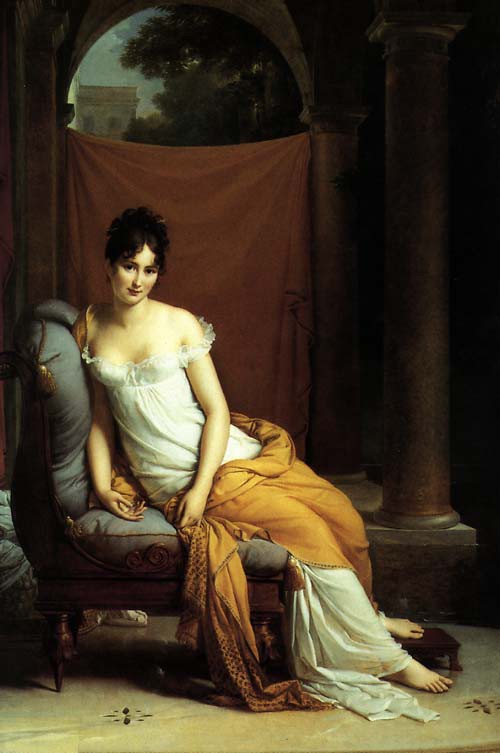
11. Napoleon Exhibits
The beautiful portrait of Juliette Recamier, a wealthy socialite, opens the next section on Napoleon and the First Empire.
Napoleon was a young general who rose quickly through the ranks, giving himself the Roman-style title “first consul” and crowning himself emperor.
You’ll see a bust of him as a young man. During his tenure, all things Neo-Classical became popular, producing portraits like Reclaimer’s, where women reclined on Etruscan couches in Greek-style robes.
12. Romanticism
From 1830 on, Paris was intellectual and artistic melting pot, swept up in the new spirit of freedom. This era was known as the Romantic period.
In one room, you’ll see the busts and portraits of writers Victor Hugo, Frederic Chopin, Giuseppe Verdi, and Franz Liszt.
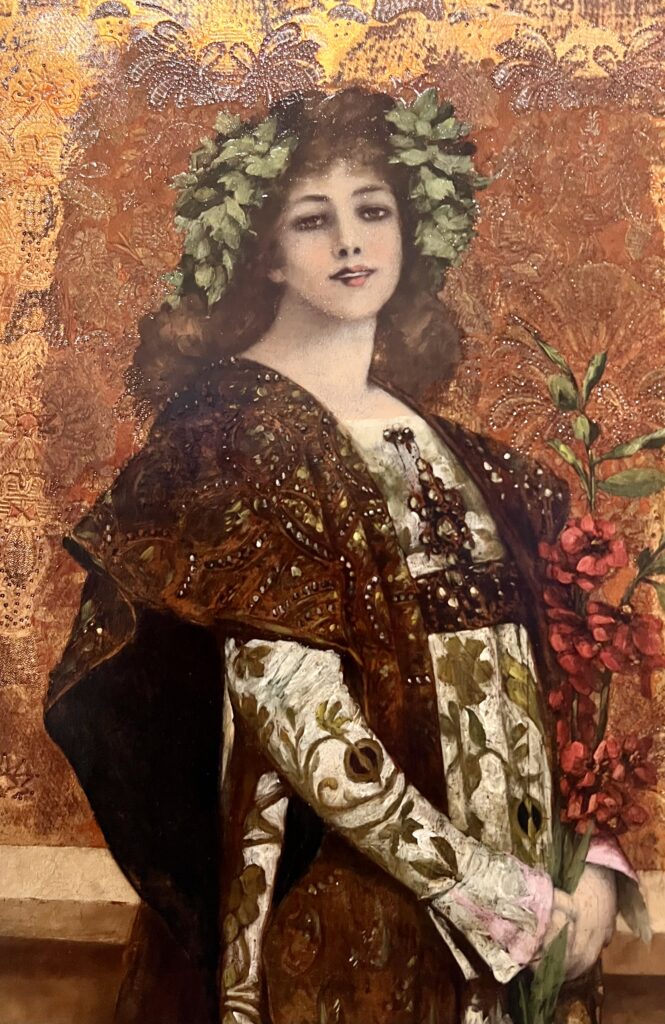
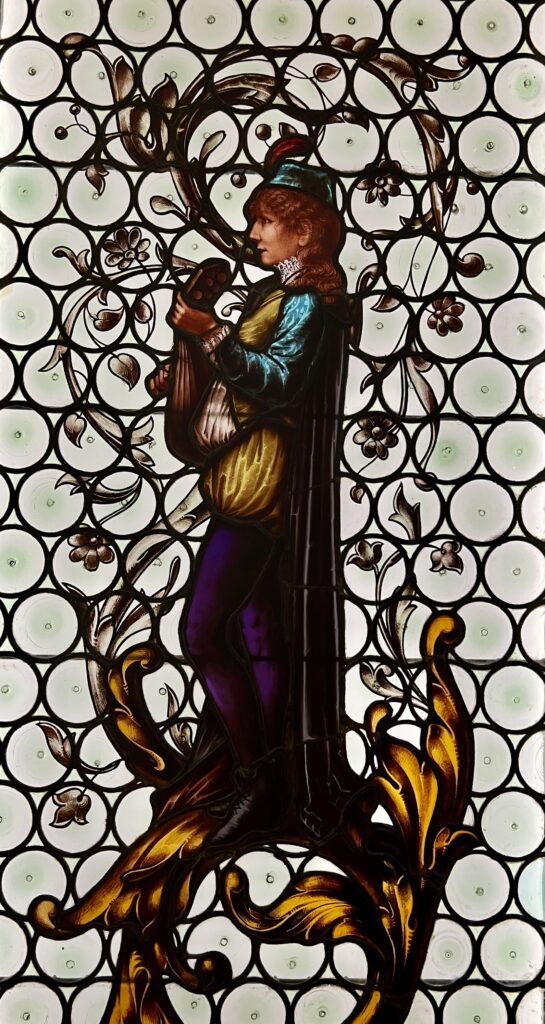
13. Belle Epoque
In the early 19th century, Paris entered a peaceful era known as The Beautiful Age. This is the time of the great exhibitions that brought us the likes of the Eiffel Tower.
Paris became a world capital of culture. In one room, you’ll see portraits of the influencers — actress Sara Bernhardt, Victor Hugo, etc.
One wall has over 40 paintings, donated by Mr. and Mrs. Seligmann, chronicling high society and Paris street scenes.
There is also an entire room taken from the Café de Paris, formerly on 41 Avenue de l’Opéra. It was a private, VIP room, where the rich Frenchmen entertained their wives or lovers.
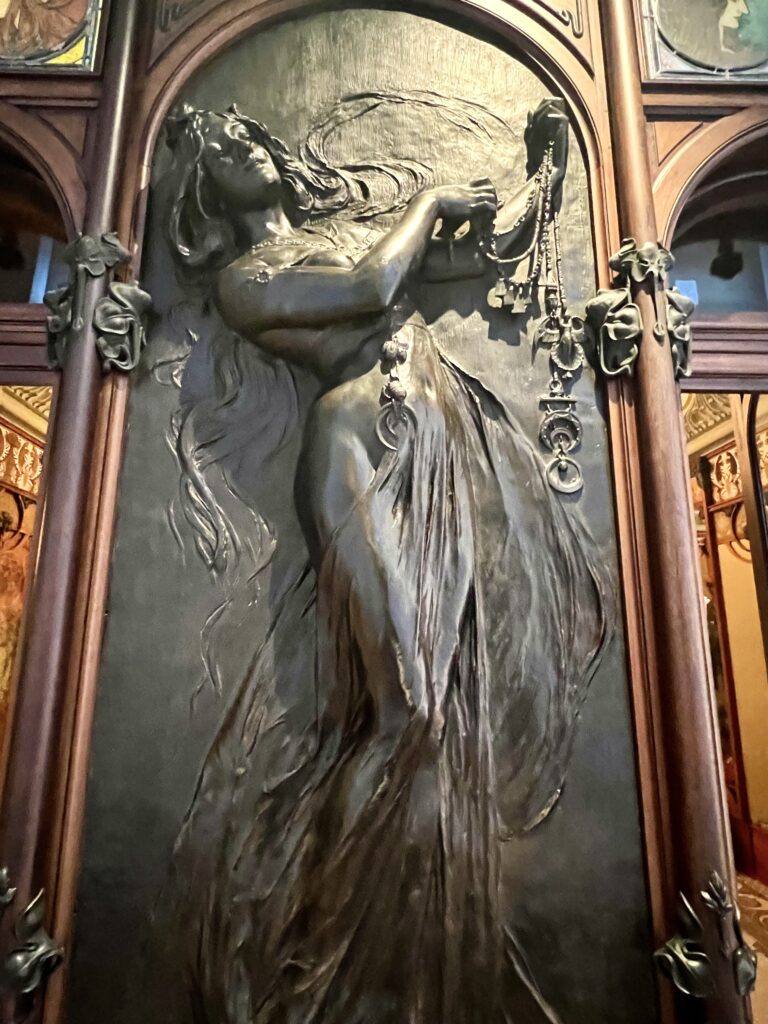
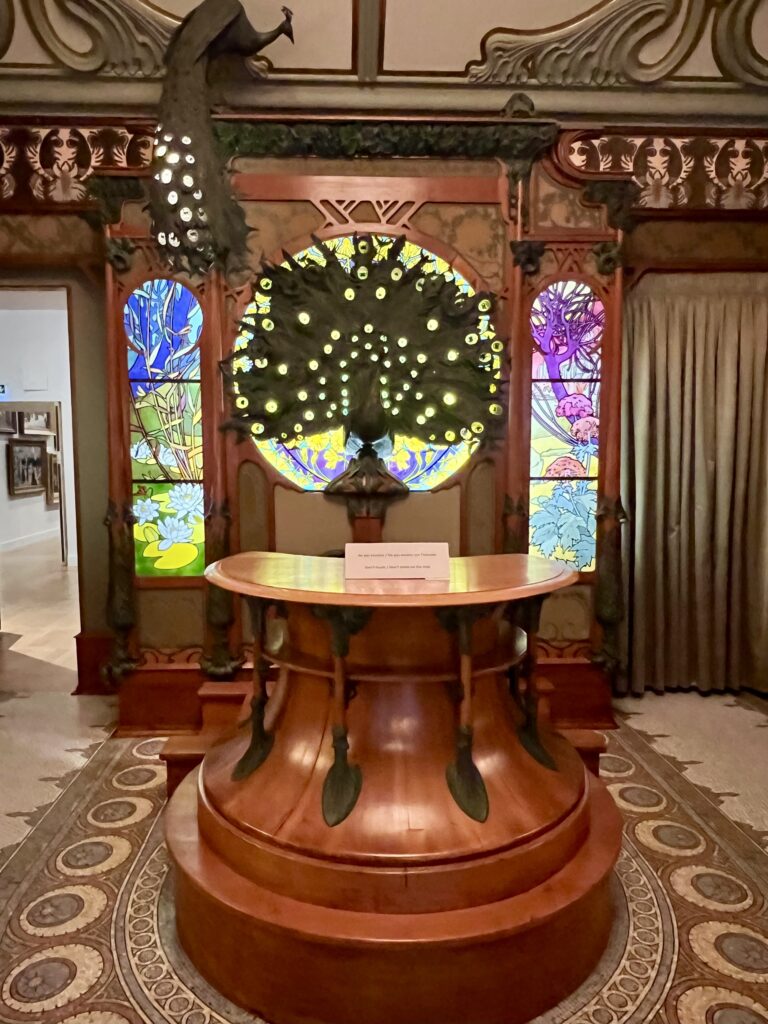
14. Fouquet Jewelry Room
Perhaps the Carnavalet’s greatest recreation is the stunning jewelry showroom designed for Georges Fouquet by Alphonse Mucha in 1901.
Having already collaborated on jewelry pieces, Fouquet asked Mucha to design his chic 6 Rue Royale shop. It’s the very height of Art Nouveau style.
A relief of a woman greets customers at the entrance, her arms and neck thrown back gracefully. Everything is decorated in flowing lines, swirls, and themes of flora. A majestic peacock sculpture spreads out against stained glass windows.
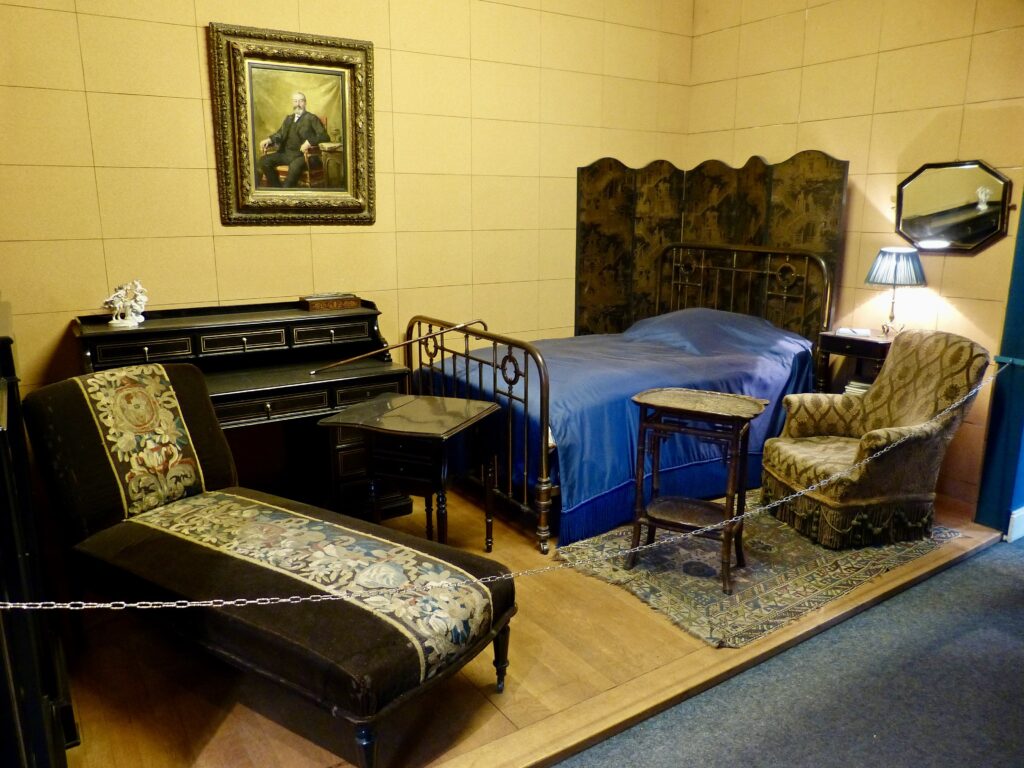
15. Marcel Proust Bedroom
The famed French novelist Marcel Proust has his reconstructed bedroom on view in the museum.
Proust’s biographer claimed that the writer penned a number of his books while seated in his lumpy blue bed.
The room is famously lined in cork. A lock of his hair, cut off on his deathbed, is displayed in a frame, along with a deathbed portrait of him by Man Ray.
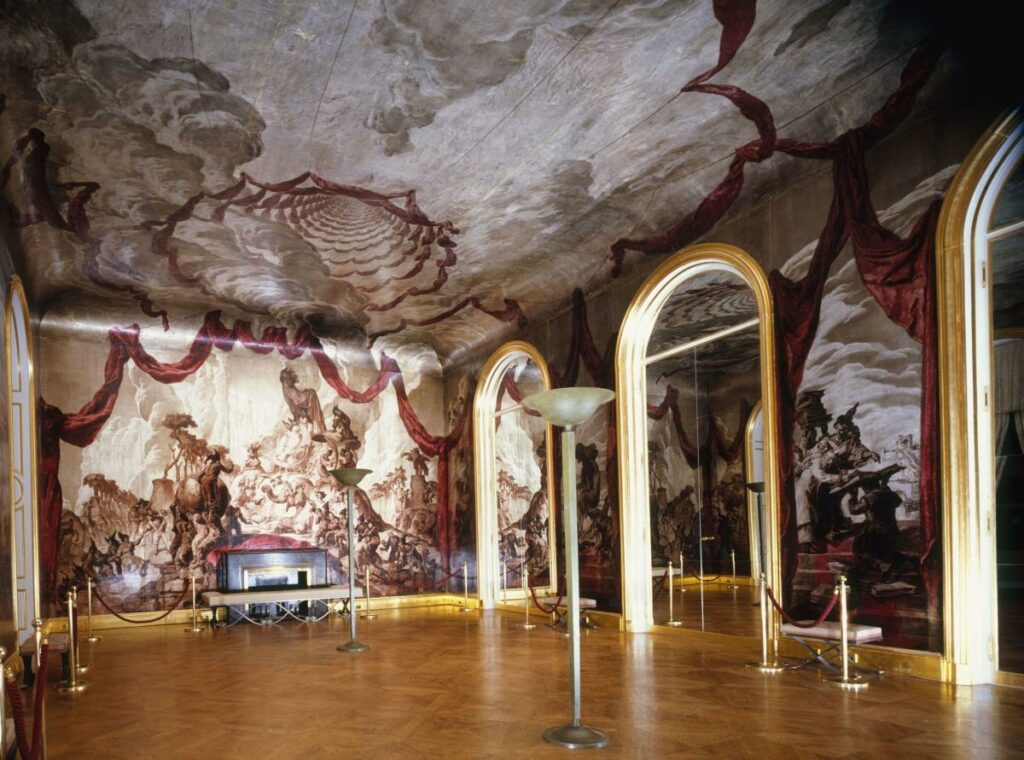
16. Wendel Ballroom
Purchased and installed in the museum in 1989, the Wendel Ballroom came from the Sourdeval-Demachy mansion. The wealthy industrialist Maurice de Wendel and his wife commissioned frescos by painter José-Maria Sert around 1925.
Heir to the Italian pictorial tradition, Sert was a master of decorative art. The viewer is immersed in his theatrical setting, framed by swirling red drapery. In the composition, the Queen of Sheba prepares to meet King Solomon sitting atop a white elephant.
The frescos were renovated when purchased. That process revealed the artist’s technique for creating luminosity. He applied three coats of glaze and rubbed it with gold metal powder.

Tips For Visiting The Musee Carnavalet
Here are some must know tips and practical information for visiting the Carnavalet Museum.
Address: 16 Rue des Francs Bourgeois
Metro: St. Paul
Entry fee:
Entry is free, except for special exhibitions. You won’t need an audio guide because there is plenty of signage in both English and French. The ticket office closes at 5:15 pm.
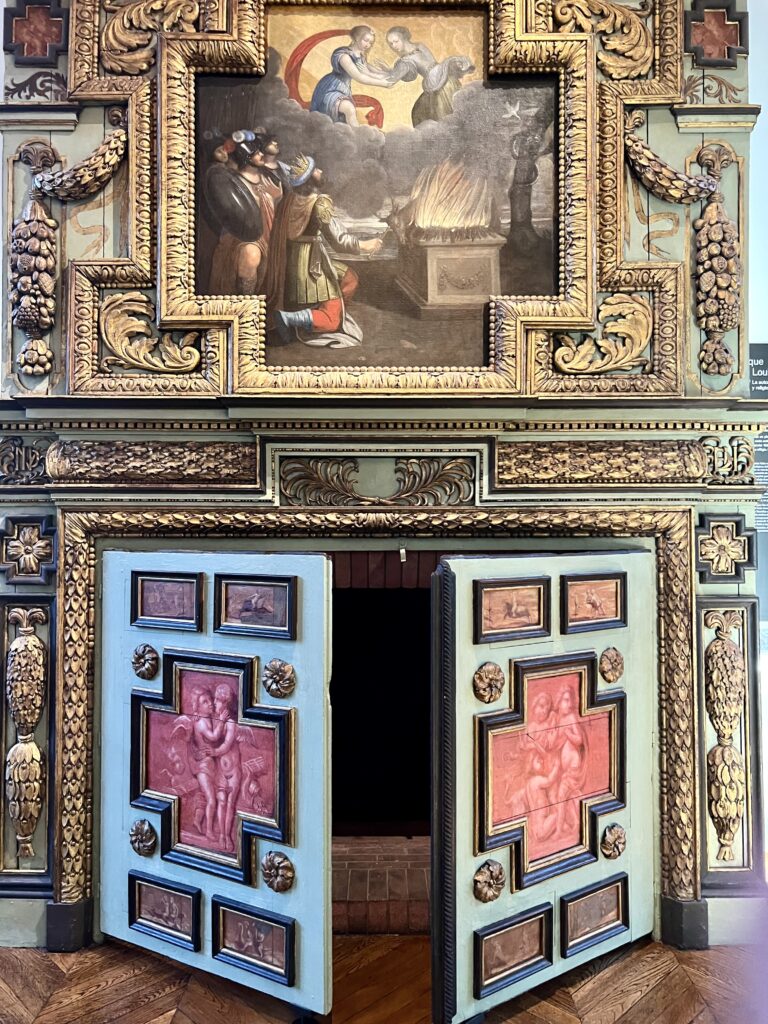
Opening Hours: Tuesday through Sunday 10:00 am to 6:00 pm.
Time Allocation:
You should allow 2-3 hours to see the collections. If you are pressed for time, head up to the second floor for the French Revolution exhibits first. Or, perhaps start there and work your way down.
Bookstore: There is a bookstore and museum shop with a range of books, souvenirs, gifts, and more.
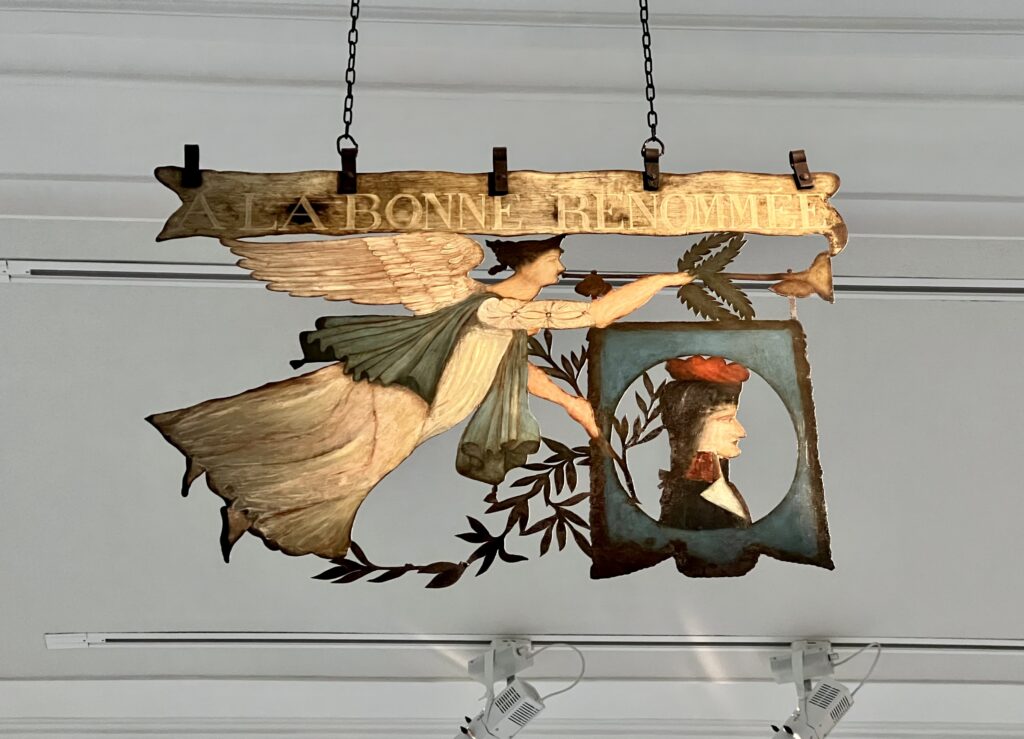
Cafe: During the renovation, the museum added a new restaurant in its enchanting garden courtyard, Fabula. The restaurant has a focus on local and season cuisine.
I hope you’ve enjoyed my guide to the Musee Carnavalet. You may enjoy these other Paris travel guides and resources:
- 5 day itinerary for Paris
- 3 day itinerary for Paris
- 2 day itinerary for Paris
- Hidden gems in Paris
- Guide To Montmartre
- Guide To the Latin Quarter
- Guide to the Marais
- Best Museums in Paris
- Louvre Survival Tips
- Guide To the Musee d’Orsay
- Secret Day Trips from Paris
Pin it for later.

